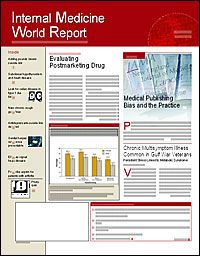Publication
Article
Internal Medicine World Report
Herpes Simplex Virus Type 2 May Be Linked to PID
Author(s):
WASHINGTON, DC?A study of women at high risk for sexually transmitted diseases (STDs) shows that there may be an important clinical relationship between herpes simplex virus type 2 (HSV-2) and pelvic inflammatory disease (PID). The data were presented at the annual meeting of the Interscience Conference on Antimicrobial Agents and Chemotherapy.
Key points
This study shows that aggressive and early treatment may prevent lesion progression.
Educate patients about how to treat themselves for recurrent herpes.
Give patients a prescription for future use, and tell them to take the pill within 6 hours of symptom onset.
This cross-sectional study included 725 young (aged 15-30 years), nonpregnant women from local STD and ?gynecology clinics. All the women had purulent cervical discharge, untreated Neisseria gonorrhoeae or Chlamydia ?trachomatis infection, symptomatic bacterial vaginosis, or sexual contact with a man who was diagnosed with gonorrheal, chlamydial, or non?gonococcal urethritis.
Overall, seroprevalence of HSV-2 was 42.6%; among the 136 women with plasma cell endometritis, 70 (51%) were HSV-2 seropositive; among the 86 women with acute endometritis, 47 (55%) were HSV-2 seropositive.
Each participant was interviewed to obtain demographic and behavioral information. Vaginal fluid was collected for the Gram's stain diagnosis of bacterial vaginosis, Trichomonas vaginalis culture, endocervical specimens for N gonorrhoeae culture, and C trachomatis polymerase chain reaction testing. In addition, serum was tested for the presence of type-specific HSV-2 antibodies, and each woman underwent endometrial biopsy.
Acute and plasma cell endometritis were significantly more common among women with HSV-2 infection. Women coinfected with HSV-2 and either C trachomatis, N gonorrhoeae, T vaginalis, or bacterial vaginosis were more likely to be diagnosed with acute endometritis by endometrial biopsy than those infected with either HSV-2 or with only 1 of the bacterial infections alone. Hysterosal?ping?ography detected fallopian tube obstruction more frequently among women with HSV-2 antibodies than among those who were HSV-2 seronegative.
Acute endometritis was independently associated with black race, C trachomatis, N gonorhoeae, T vaginalis, and HSV-2; the sole reproductive tract infection significantly associated with plasma cell endometritis was HSV-2.
"It's very preliminary, but if genital tract reactivation of HSV-2 is associated with increased upper genital inflammation, then theoretically you should be able to suppress HSV-2 reactivation and decrease chances of PID," said lead investigator Thomas Cherpes, MD, of the University of Pittsburgh School of Medicine. "Until now it was not thought that a virus could be associated with PID. It was thought that the problem was entirely caused by bacterial infections."
Dr Cherpes said that HSV-2 had previously been isolated from the upper genital tract of women with endometritis and PID; however, its involvement in the pathogenesis of these diseases has not been well studied.
"This is not a randomized study, so more research is needed. But PID is the number one cause of infectious infertility, and so finding new ways of preventing PID is important," Dr Cherpes told IMWR.
"Treating herpes may turn out to be useful for PID....We know some other STDs travel together, and controlling one can control another one, and that may be the same with some cases of PID," commented Fred Aoki, MD, of the University of Manitoba, Winnipeg, Canada.





